The A
Dance with Butterflies project fit in very nicely with the
introduction to my science unit of life cycles. It was
approached through the language area of the curriculum with Read
Alouds, Shared reading and writing, research presented in T
charts and Venn diagrams, and poetry writing. It also reached
into the music, art, drama, and math areas of the curriculum.
- Read
alouds: Waiting for Wings by Lois Ehlert A Very Hungry
Caterpillar by Eric Carle Tony and the Butterfly A Ginn reader
Darkness and the Butterfly by A. Grilfaconi
- Shared
Reading: A Butterfly is Born by Melvin Berger Newbridge Big
Book, small readers and cassette tape:
- Video:
Rebecca in the Meadow
- Personal
research books.
CHORAL
READING: Students of varied reading levels worked together to
learn poems. They worked on expression, clarity, and rhythm
while reading the poem together. I found the poems on the web.
The Cocoon Author unknown
I found a
cocoon that a caterpillar made,
Fastened to a leaf hanging in the shade.
He barely had room to wiggle or wag,
Like me zipped up in my sleeping bag.
I looked each
time that I passed his way,
But he never budged until just today.
Something happened! He wagged and wiggled
And then climbed out and carefully jiggled
Small wet wings that grew as they dried.
He'd turned to a butterfly inside!
Birth of a Butterfly By Meish Goldish
A mama
butterfly lays all her eggs,
Out pops a caterpillar, crawling on its legs.
The caterpillar first is rather thin, But then it eats till it
bursts through its skin.
After growing nice and big, The caterpillar climbs on a leaf or
twig.
It makes a shell where it hangs inside.
The shell then cracks, and the parts divide.
Inside the shell, a change was going on,
The form of the caterpillar now is gone.
When the shell opens, what comes out?
A beautiful butterfly fluttering about!
Music:
Students of varied reading/playing levels worked together to
learn to sing and play songs.
- Learn
to sing the song Butterfly Cycle to the suggested tune �Row,
Row, Row Your Boat.� Students use head phones hooked up to the
recorded melody on the electric keyboard to practice singing
the song.
Butterfly
Cycle � 2003 Suzy
Gazlay
Hatch,
hatch little egg, I'm so very small.
Teeny tiny caterpillar you can't see me at all.
Crawl, caterpillar, crawl, munching on a leaf.
Crawling, munching, crawling, munching, eat and eat and eat.
Form, form chrysalis, I'm a different shape; Hanging by a silken
thread until I can escape.
Rest, rest, chrysalis while I change inside; Now at last my time
has come to be a butterfly.
Stretch, stretch, pretty wings, It's a special day; Soon they
will be strong enough for me to fly away.
Fly, fly, butterfly, fly from flower to tree; Find a place to
lay my eggs so they can grow like me.
Butterfly, Butterfly Author unknown
Butterfly,
Butterfly, Fly Away,
You were a caterpillar yesterday
Butterfly, Butterfly
You never stay, Always flying to a new day.
We know
the fingering for G A B. I composed a tune using these three
notes for the poem Butterfly, Butterfly. I printed the poem on
chart paper and used three colours over the words/syllables as
the indication of the pitch to be played.
ti ti ta
ti ti ta ta ta taa ta ti ti ti ti ti ti ta ta taa
G G G A A A B B A G G G A A A A B B
A Butterfly, Butterfly, Fly Away, You were a caterpillar
yesterday
ti ti ta
ti ti ta ta ti ti taa ta ta ta ta ti ti ta taa
G G G A A A B B B A G A B B A A A G
Butterfly, Butterfly You never stay, Always flying to a new day.
(ti = eighth note, ta-= quarter note, taa = half note)
-
Create a
sound collage on non-pitched instruments of sounds �heard� in
the poem The Cocoon. The sounds are played during the choral
reading to emphasize sounds mentioned in the poem. Students
can choose from castanettes, drums, triangles, cylinders,
woodblocks, sand blocks, bells, sticks, maracas and
tambourines.
Art:
1. Puppet show: Art and puppetry
-
Create
puppets of the eggs on leaves, larva, pupa and butterflies
using construction paper, straws and glue
-
Create
a large painted background.
-
Perform
a play with the puppets to accompany the song Butterfly Cycle
2. Display
Posters: Art and computer
-
Produce
posters of the life cycle of a butterfly using construction
paper and glue.
-
On
the computer type up labels and information about each stage.
-
Glue
the pictures and information of each stage onto a separate
sheet of paper.
Drama:
Movement
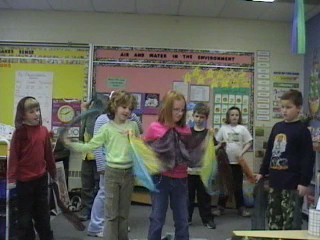
Presentations: For our culminating activity to demonstrate the
life cycle of a butterfly the students were given the
choice of choral reading or
singing, and art or drama. Students worked in groups, with 7 or
8 members, on the two projects they were most comfortable with.
Then two groups joined together to work on the coordinating of
an oral and visual presentation. The presentations were
videotaped.
The Cocoon
- Choral
reading of the poem with soundscape of non-pitched instruments
- Drama
presentation
Butterfly
Cycle
- Singing
of the song
- Puppet
Show
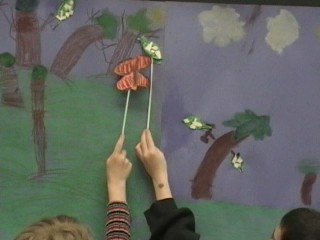
Birth of a
Butterfly
- Choral
reading of the poem
- Posters
of the butterfly life cycle

Butterfly,
Butterfly
-
Performing a rondo by playing on precorder, singing, playing
on precorder
Writing:
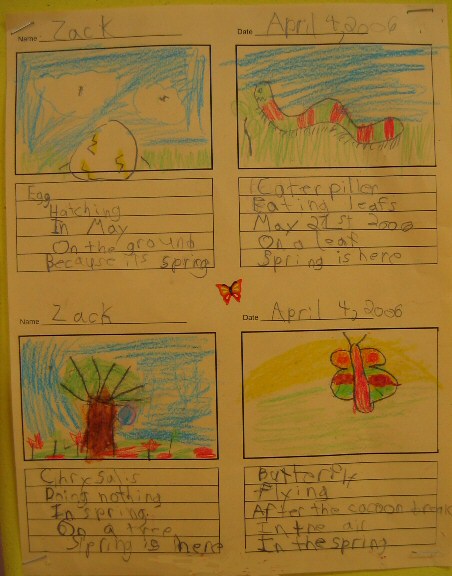
Art:
Using the
information on butterflies in Waiting for Wings students created
a multimedia art work of the butterfly life cycle.
-
Dry brush paint the stems and leaves onto a beige sheet of
construction paper
-
Using small amounts of plasticene make 3-D eggs, caterpillars,
chrysalises and a butterfly
- Label
the art work with the name of the kind of butterfly. (Monarch,
Buckeye, Painted Lady or Tiger Swallowtail )
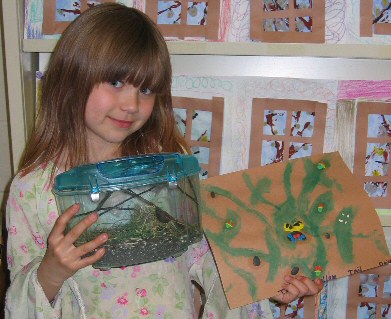
An added
bonus to our unit: Due to our spring being unseasonably warm
this year, one of the students brought in two Woolly Bear
caterpillars complete with research from the net. These
caterpillars are destined to be Isabella tiger moths. From our
readings we knew how to set up a terrarium and made our new
friends comfortable. Soon after the caterpillars arrived, one
formed a cocoon. From our research we made predictions of when
the moths will emerge. How exciting for the students. We learned
about emerging from a cocoon, we dramatized it and then we got
to see it actually happen. On May 1st our Isabella Tiger moth
emerged.
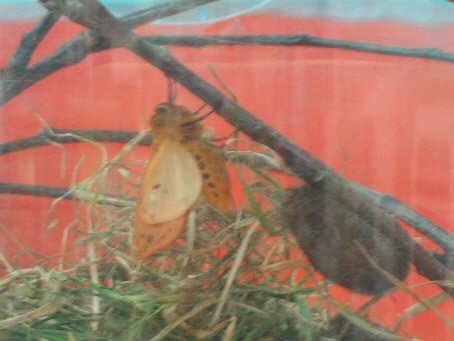
Ontario Grade 2 Curriculum links
Science: Life Systems: Growth and changes in
Animals
�
Compare the life cycles of animals that have
similar/dissimilar life cycles.
�
Compare ways in which animals eat their food,
move and use their environment to meet their needs.
�
Identify constant traits and changing traits in
animals as they grow, and compare the appearance of young and
mature animals of the same species
Writing:
�
Produce short pieces of writing using simple
forms
�
Communicate ideas for specific purposes
Reading:
�
Express clear responses to written materials,
relating the ideas in them to their own knowledge and experience
�
Independently select stories and other reading
materials by a variety of authors
Oral and Visual Communication:
�
Create simple media works.
Visual Arts:
�
Produce two- and three-dimensional works of art
for specific purposes
Music:
�
Create and perform musical compositions
�
Create short songs and instrumental pieces, using
a variety of sound sources
�
Produce a specific effect using various sound
source
Drama and Dance:
�
Recognize and demonstrate movement sequences
found in their natural surroundings (sequence of movements of a
butterfly emerging from a cocoon.)
Math
�
Measure and record the distance around an object |